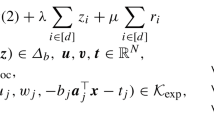Abstract
The equivalence of multinomial maximum likelihood and the isotonic projection problem:
can be established using Fenchel's Duality Theorem and subgradient and complementary slackness relationships of convex analysis, all taking place over the real numbers.
In this paper non-Archimedean polynomial subgradients (Jeroslow/Kortanek '71, Blair '74, Borwein '80, and Kortanek/Soyster '81) are employed for the case where some of the observed values of the random vector are zero, corresponding to “zero counts in the traditional multinomial setting.” With an appropriate linear semi-infinite programming dual pair it is shown that a vector solves the multinomial problem if and only if it converts to a solution of the isotonic projection problem. The development parallels the one of Robertson/Wright/Dykstra '88, where for the zero counts case the authors adjoin “-∞” to the real numbers and define ln(0)=-∞.
Similar content being viewed by others
References
Ben-Israel A, Charnes A, Kortanek KO (1971) Asymptotic duality in semi-infinite programming and the convex core topology. Rendiconti di Matematica 4: 1–17
Ben-Tal A, Teboulle M, Charnes A (1988) The role of duality in optimization problems involving entropy functionals with applications to information theory, J. Optimization Theory & Applications 58: 209–223
Blair CE (1974) An extension of a theorem of Jeroslow and Kortanek. Israel J Math 17: 111–115
Brockett PL, Charnes A, Cooper WW (1980) M.D.I. Estimation via unconstrained convex programming. Comm. Statist.-Simul. Comput B9(3): 223–234
Borwein JM (1980) Lexicographic multipliers, J. Math. Analysis & Applications 78: 309–327
Borwein JM, Lewis AS (1992) Partially finite convex programming, Part I: Quasi relative interiors and duality theory, Mathematical Programming 57: 15–48
Charnes A, Cooper WW, Tyssedal J (1983) Khincin-Kullback-Leibler estimation with inequality constraints, Math. Operationsforsch. u. Statist., ser. optimization 14: 377–380
Duffin RJ, Zener C (1970) Geometric programming and the Darwin-Fowler method in statistical mechanics. J. Physical Chemistry 74: 2419–2423
Gochet WF (1973) Computational Treatment of Some Linear Programming Optimization Problems with Applications to Geometric and Probabilistic Programming, Ph.D. Thesis, Graduate School of Industrial Administration, Carnegie-Mellon University
Jeroslow RG, Kortanek KO (1971) On semi-infinite systems of linear inequalities. Israel J. Math. 10: 252–259
Klafszky E, Mayer J, Terlaky T (1989) Linearly constrained estimation by mathematical programming. European J. Operational Res. 34: 254–267
Klee V (1957) Extremal structure of convex sets. Archiv der Mathematik 8: 234–240
Kortanek KO (1976) Perfect duality in generalized linear programming; In Survey of Mathematical Programming, Proc., 9th Inter. Math. Programming Symp. Budapest, A. Prekopa, Ed., Publishing House, Hungarian Academy of Sciences, 43–58
Kortanek KO (1976) Perfect duality in semi-infinite and generalized convex programming; In Methods of Operations Research XXV, First Symposium on Operations Research, Verlag Anton Hain, 79–87
Kortanek KO, Soyster AL (1981) On equating the difference between the optimal and marginal values of a convex program. J. Optimization Theory and Applications 33: 57–68
Marshall AW, Walkup BW, Wets RJB (1967) Order-preserving functions: applications to majorization and order statistics. Pacific J. Math. 23: 569–584
Raubertas RF, Lee CIC, Nordheim EV (1986) Hypothesis tests for normal means constrained by linear inequalities. Comm. Statist.-Theor. Math. 15: 2809–2833
Robertson T, Wright FT, Dykstra RL (1988)Order Restricted Statistical Inference. John Wiley & sons, New York
Rockafellar RT (1970)Convex Analysis. Princeton University Press, Princeton, N.J.
Stoer J, Witzgall C (1970) Convexity and Optimization in Finite Dimensions I. Springer-Verlag, New York
Author information
Authors and Affiliations
Rights and permissions
About this article
Cite this article
Kortanek, K.O. Semi-infinite programming duality for order restricted statistical inference models. ZOR - Methods and Models of Operations Research 37, 285–301 (1993). https://doi.org/10.1007/BF01415997
Received:
Revised:
Issue Date:
DOI: https://doi.org/10.1007/BF01415997




